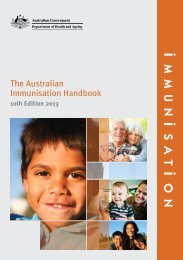3.30 MB - Academy of Medicine of Malaysia
3.30 MB - Academy of Medicine of Malaysia
3.30 MB - Academy of Medicine of Malaysia
You also want an ePaper? Increase the reach of your titles
YUMPU automatically turns print PDFs into web optimized ePapers that Google loves.
MANAGEMENT OF HIV INFECTION IN CHILDREN<br />
6.2 AGE APPROPRIATE EDUCATIONAL & LIFESTYLE ADVICE FOR<br />
CHILDREN AND ADOLESCENTS<br />
HIV infected children, adolescents and their caregivers should be given<br />
appropriate advice regarding behaviour and lifestyle to minimize the risk <strong>of</strong><br />
HIV transmission. The advice provided must be appropriate to the age and<br />
maturity <strong>of</strong> the child.<br />
The risk <strong>of</strong> a young child infecting others is extremely small. Although HIV<br />
has been isolated in the saliva, tears, urine and faeces, there is no evidence<br />
246, Level 9<br />
that HIV can be acquired through casual contact with these sources.<br />
Families and caregivers should be assured that sharing <strong>of</strong> household<br />
utensils, linen, clothes, personal hygiene products and close daily interactions<br />
(including kissing) are safe and do not result in the transmission <strong>of</strong> HIV.<br />
Having an infected child in a day-care centre or school poses no risk to staff<br />
or other children. No case has ever been recorded <strong>of</strong> HIV transmission from<br />
child to child by playing, fighting or any other normal childhood interaction.<br />
Although biting poses a theoretical risk <strong>of</strong> transmission, the risk is believed<br />
to be extremely low. 249, Level 9 ; 250, Level 9 If an infected child has a cut or graze, this<br />
should be dealt with in the normal manner following first aid procedures and<br />
standard hygiene practices. Schools should be assisted to develop a norm<br />
in which universal or standard precautions for infection control are routinely<br />
employed by staff and students (see Appendix 9 for additional resources).<br />
As the child grows up into adolescence, several pertinent issues must be<br />
addressed (see following table). Disclosure <strong>of</strong> the diagnosis is important and<br />
frank and open discussion is vital so he/she can participate in decisions<br />
regarding treatments, care and prevention <strong>of</strong> transmission to others. Specific<br />
issues regarding lifestyle or behaviour that potentially could transmit HIV,<br />
especially sexual activity and substance abuse must be addressed. These<br />
prevention messages should be regularly provided to HIV infected<br />
adolescents at every opportunity.<br />
51

















